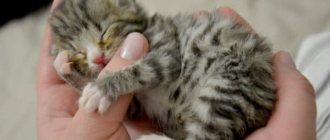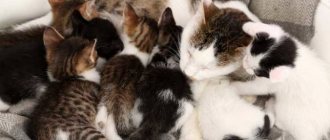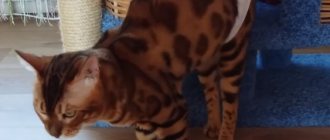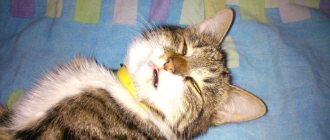How to reduce the risk of abandonment of offspring
Try to follow the basic rules:
- the cat should have a warm and quiet place for giving birth and subsequent feeding of kittens;
- the cat should eat food high in nutrients;
- there is no need to touch kittens in the first two weeks of their life unless necessary;
- other pets should not have access to the cat with kittens, including the cat.
If the cat does abandon the little kittens, there are other possible reasons:
- the cat is too young and this is her first birth;
- too many kittens;
- after giving birth, the cat developed complications, for example, mastitis;
- the cat has no milk;
Contact your veterinarian for advice. Try to feed the cat food with a high content of nutrients, move her house to a quiet and peaceful place - perhaps after a short time the maternal instinct will kick in and she will return to her cubs.
Possible problems for a cat after giving birth
- Hormonal imbalance leading to disruption of lactation. After childbirth, alarming symptoms often appear, consisting in the inability to process glucose. This leads to a state of shock. The condition improves after injection with insulin, but it is better to get tested and consult a veterinarian;
- Stressful state. It arises due to human intervention (intentional or accidental). For example, in the first hours after birth, kittens were picked up and moved or the nest was moved. A change of bedding or furnishings, or bright light could frighten the young mother. The cat may eventually take back her offspring. In this case, the owner should try to provide comfort and, as soon as the young mother calms down and finds a closed place, she needs to put a nest with kittens there.
- Birth of non-viable kittens. It also happens that the offspring are too numerous, and the mother cat, feeling a lack of milk, does not feed the weak (but potentially having a chance to survive) babies. In this case, the owner has to provide assistance in caring for the offspring;
- Complicated childbirth and its consequences - endometritis, mastitis, etc. A cat does not think about its offspring if it feels pain, it only cares about its own condition. Some animals in a state of “postpartum insanity” may crush, tear to pieces or eat their babies.
- Too early (by cat standards) birth and pregnancy. The animal does not reach puberty and becomes pregnant. But it does not want to raise its offspring further.
- Lack of calcium or eclampsia is a dangerous condition for a young mother, requiring injections with the appropriate microelement and observation of the animal.
It may turn out that the reason for the reluctance to feed is a weak condition. If the cat rests, it will gain strength and begin to fulfill its duties towards the offspring.
There is no need to panic; it is better to provide the nurse with a large volume of liquid - milk, broth and water. Kittens need warmth while their mother is away. You will need a heating pad in soft fabric, which is placed in the nest. The cat needs to be calmed down, caressed, and treated to something tasty by all means.
How to feed a kitten
Unfortunately, such measures do not always lead to the return of the mother to her offspring. You will have to take on the responsibilities of being a mother. The best option would be to give the kittens to be raised by another cat that has just given birth. If you cannot find a nursing cat, you will have to try to feed the kittens at home.
- How to properly feed a kitten without a mother? First of all, you need to purchase a special mixture for newborn kittens at a pet store. The composition of such mixtures is very similar to mother's cat milk. Under no circumstances should you feed your kitten natural cow's milk: it is very different in composition from cat's milk and can lead to intestinal problems.
- Before feeding the kitten, you need to stimulate it: stroke its head, back, and tummy, imitating maternal licking.
- The temperature of the feeding mixture should be 36–38°C. Before feeding your kitten, place a drop of the mixture on your wrist to check the temperature. It is best to feed your kitten using a disposable syringe without a needle - this way you can control the portion size.
- In the first week of life, kittens need to be fed every 2 hours. In the second week, the frequency of feedings is reduced to 8 times a day. From the third week, kittens need to be fed only during the day, but at least 6 times a day.
- How much should a kitten eat? Pay attention to his behavior. A full-fed kitten falls asleep almost immediately. If there is not enough food, the kitten will continue to squeak and poke at your hands in search of a pacifier.
- After each feeding, the cat licks her litter to stimulate digestion and help the kittens go to the toilet. After each feeding, you will have to wipe the kitten's belly and butt with a soft cloth soaked in warm water.
Why don't some cats accept kittens?
There are situations when a cat does not feed newborn kittens due to a state of shock (in primiparous females), with complications of an inflammatory nature in the reproductive system, after a difficult birth and with a lack of maternal milk.
The owner can notice that something is wrong by the expressed anxiety of newborn babies and at control weighings of the offspring (small weight gain). Hungry kittens squeak, sleep poorly, and are always in search of their mother's nipple. There may be several reasons for this phenomenon:
- natural low milk production of the cat;
- unbalanced nutrition of a nursing mother;
- stress factors;
- a large number of babies in one litter;
- diseases of internal organs (this includes postpartum complications);
- hormonal imbalances;
- reduced maternal instinct.
The owner’s task is to monitor the process of feeding the kittens, their behavior and condition. This will make it possible to timely detect a lack of milk and properly organize complementary feeding. It is recommended that you contact a qualified veterinarian who can help diagnose possible problems and provide recommendations for eliminating them.
Once a cat’s milk deficiency is detected, it is necessary to immediately begin feeding the babies. Metabolic processes in kittens occur unusually quickly, so malnutrition negatively affects their condition already in the first days.
If the cat does not feed the offspring, it is necessary to take care of specialized mixtures. Whole cow's milk is not recommended for supplementary feeding. It is too fatty and is not absorbed by kittens in the required quantity. In addition, there is a risk of developing disorders in the digestive system.
You can replace cat milk with whole fresh goat milk or formulas intended for supplementary feeding of puppies. Breeders use infant formula to artificially feed kittens, but they must first be diluted in a ratio of 1:1.5, since the concentration for a human baby is not suitable for kittens.
In the process of supplementary feeding, it is necessary to follow a number of rules:
- warm the mixture to 38 degrees before feeding;
- do not store ready-made milk formula for more than 4 hours;
- monitor the cleanliness of bottles and nipples (allows you to prevent the development of dangerous infectious diseases);
- feed after the process of sucking the mother's nipple.
Weak kittens have a poor sucking reflex and find it difficult to obtain milk for themselves. It is advisable to place the babies next to the cat's last pair of milk bags, as they always contain more milk. Be sure to weigh kittens regularly to determine weight gain.
When feeding orphan kittens left without a mother or those that the cat refused to feed, the owner must adhere to the basic rules:
- for the first 7 days, feed babies every 2 hours (and at night);
- starting from day 8, feeding is carried out every 3 hours;
- From 3 weeks, kittens are fed every 4 hours.
It is necessary to closely monitor the condition of the babies, regularly massage the tummy, normalizing the functioning of the digestive tract. It is important to consult your veterinarian regarding changes in your pet's condition.
What to do if you are not ready to accept the death of kittens? There are several options to solve the problem.
The cat abandoned the kittens, what to do:
- The simplest and most profitable way is to find a nursing cat. Very often, cats add new babies to newborn kittens that their mother has abandoned. Oddly enough, cats usually never separate kittens and do not throw them out of the nest or box. Accordingly, they take care of them in the same way as their offspring.
- Where can you find a cat? There are many veterinary forums and animal shelters. This is where you can find a nursing cat. In this case, you will have to take her home with your offspring.
- This is the simplest option, because the cat requires not only milk, but also other skills and functions.
kittens
, well cared for by their mothers, are round, pink and clean. They sleep peacefully, cuddling close. When a cat refuses children, it hisses, steps on them, and avoids them. In the absence of feeding, babies do not gain weight. They are lethargic, cold, unkempt, and have a low breathing rate.
There are a number of reasons why a female mother ignores her newborns. They may be behavioral, caused in part by hormonal imbalances. Sometimes a cat will not accept kittens due to a medical condition that makes her unwilling or unable to care for her children.
Some mother cats believe that the first kitten born is the only one. They focus on him and ignore others. Sometimes a female rejects a litter born by Caesarean section, as well as due to undeveloped maternal instinct.
Animals can abandon their young due to stress caused by obsessive attention from their owners, bright light, noise, poor living conditions, and malnutrition. A difficult birth can frighten a mother so much that she refuses to care for her offspring (avoids the source of pain).
Alien smell can cause kittens to be abandoned. Do not touch them with your hands without medical gloves. You can correct the situation by “marking” the cubs with their native smell (cat milk, urine). As a last resort, apply your pet’s favorite treat to the “refuser”.
Sometimes the female instinctively abandons and stops feeding a weak cub (especially in a litter that is too large) - one with a birth defect, illness, or parasites. In the wild, this is a normal occurrence to conserve limited resources and prevent the spread of disease in the litter.
We invite you to read: Ultrasound removal of tartar in cats. Treatment of tartar in cats: causes, symptoms, prevention. Causes of tartar formation
Any disturbance in the endocrine or nervous system - a decrease in the levels of prolactin, oxytocin, serotonin, dopamine - affects the instincts, prompting the female to ignore her children.
A cat will not accept kittens if she does not produce milk. This problem may occur due to a defect in the pituitary gland: low levels of the hormone prolactin lead to insufficient development of the mammary glands during pregnancy.
Another reason for lack of milk is malnutrition. A pregnant female should eat 2-2.5 times more calories per day than a normal female. If the amount of food and water is insufficient, weight loss and dehydration will reduce lactation.
Sometimes the breasts can become inflamed due to infection, a condition called mastitis. Swelling and pain occur in the affected glands. The milk becomes yellow, thick and occasionally bloody. The female's temperature rises, she becomes lethargic and loses her appetite.
Often, a cat refuses to feed due to painful hardening of the mammary glands due to eclampsia (low calcium levels), stagnation of milk, postpartum diseases of the uterus, peritonitis. When an animal is in pain or unwell, it has no desire to care for its offspring.
Poor mothering is the most common cause of disease and death in newborn offspring. It is important that kittens receive antibody-rich colostrum within the first 24 hours after birth. This is protection against diseases, since their immune system is not yet developed.
If there is not enough colostrum, they will be at risk of contracting infections. During the first four weeks of life, kittens need their mother's milk. If “refuseniks” are malnourished, they gain weight poorly, become weak, get sick and die.
If your pet is a first-time mother and refuses to nurse newborns, apply them to her nipples. Sucking will release hormones, which will improve her mothering behavior. If the cat is physically healthy, you can try to gently “persuade” her to care for the babies.
Place the mother and her kittens in a quiet, private area of the house. Try not to disturb the cat family often, place food, water and a litter box nearby so that the cat can reach them without leaving her newborns for a long time.
Observe the animal's temperature and condition, and check the mammary glands for lumps, milk, or abnormal vaginal discharge indicating an infection in the uterus.
Examine kittens for any signs of disease or birth defects. If you find weak individuals or your cat is behaving inappropriately, take them to the vet. Try to find another lactating female for the “refusers” or start feeding them using special mixtures.
Ask your veterinarian how to care for newborns and how much and how often to feed them. These parameters change as they get older, so it is best to work closely with your veterinarian during this critical period.
Self-feeding kitten
At the age of three weeks, you can begin to introduce complementary foods into the kittens' diet. To avoid causing digestive disorders, portions should be very small, about the size of a pea.
What can and cannot be fed to kittens?
Can:
- food of soft and delicate consistency for kittens, preferably in the form of mousse.
It is forbidden:
- raw meat and fish;
- fatty, salty and fried foods;
- chocolate and sweets;
- food from your table.
How often should you give your kitten food? After introducing complementary foods, the frequency of feedings can be gradually reduced. In any case, consult your veterinarian regarding nutrition and introduction of complementary foods.
Creating conditions for kittens
To raise a kitten without a cat, you will have to replace the mother not only in the feeding process. You need to provide the kittens with a place to sleep and play, learn how to wash the kitten, and give it a massage.
- A place to sleep. You can use a small box as a sleeping place. Place soft cloths, baby diapers or towels there. During the first weeks of life, the temperature of the kittens' bed should be similar to the mother cat's body temperature. The room temperature will need to be maintained at 29-32°C, then gradually reduced to 24°C. If kittens are cold, use a warm water bottle or a small heater as a heating pad. The sleeping area should be clean, so wash the bedding promptly, being careful not to use chemical cleaners.
- Washing and massage. It is best to wash the kitten with a cotton pad or soft cloth soaked in warm water. When washing, imitate the movements of a mother cat - move along the kitten’s fur in one direction, from top to bottom. Before and after each feeding, it is necessary to massage the kitten's tummy to stimulate digestion and bowel movements.
Visits to a veterinarian
If you have any questions about caring for kittens, please contact your veterinarian. He will tell you all the nuances, talk about vaccinations and check the pet’s health. Be sure to visit the clinic if something in the kitten’s behavior or appearance confuses you. Reasons for visiting a veterinarian may include discharge from the kitten's eyes or nose, unusual lethargy, lack of appetite, unusual stool, and injuries.
Caring for newborn kittens is a difficult and responsible task, but with proper attention and patience, you will be able to feed and raise them.
Caring for orphan kittens
When raising orphans, it is important to monitor the sanitary condition of the nest. To arrange it, it is better to use disposable baby diapers. Cleanliness for newborn babies is the key to health and prevention of viral infections.
Feeding babies without a mother is not as easy as it might seem. It’s especially difficult to get through the first week together. However, the experience of many breeders proves that even if a cat refuses her babies, it is quite possible to get them out on their own. The main thing is to have enough strength, patience and, of course, knowledge of the basic rules.
The situation when a newborn kitten is left without a mother is a common event. A cat can die, get sick, give up kittens, and then the person takes on all the troubles of feeding and caring for the baby.
Newborn (from birth to 10 days). When born, the weight of babies ranges from 70 to 120 grams. This is the most defenseless period of life. The kittens are blind, have poor hearing, and practically cannot move.
Therefore, it is important to have an idea of the duration, frequency and other key points of keeping and feeding newborn kittens.











